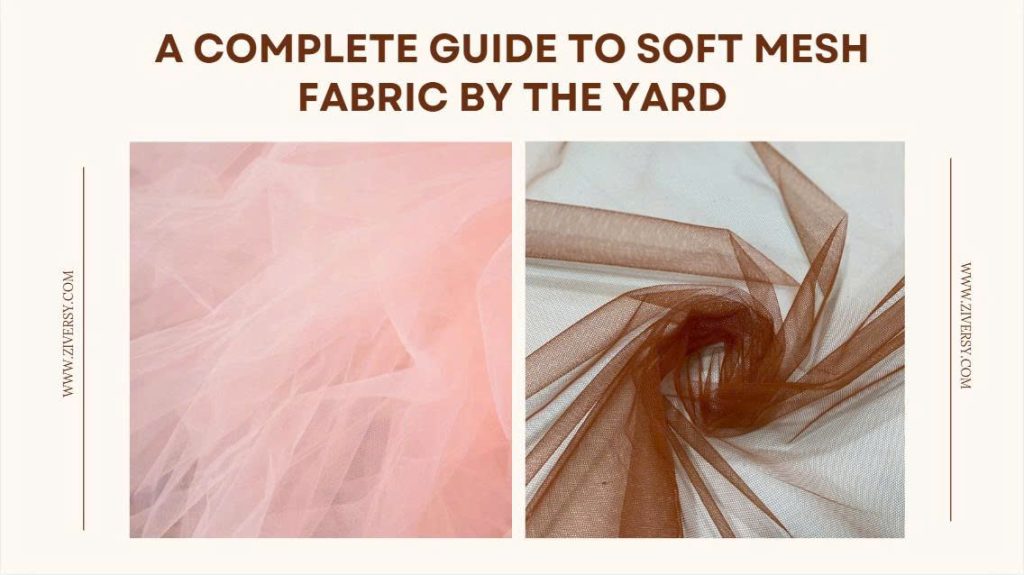Blog
A Complete Guide to Soft Mesh Fabric by the Yard
Soft mesh fabric has become a cornerstone material in the modern textile industry, perfectly balancing style, comfort, and performance. Thanks to its lightweight texture, breathability, and flexibility, this fabric has earned its place as a top choice for both garment producers and textile distributors. From trendy athleisure outfits to elegant lingerie and evening gowns, soft mesh fabric brings endless creative possibilities to the world of fashion.
This guide explores the key characteristics, practical benefits, and sourcing strategies for soft mesh fabric. Whether you’re looking to improve your production efficiency or expand your fabric portfolio, this article will help you stay ahead in a competitive global market.
What Is Soft Mesh Fabric?
Soft mesh fabric is a lightweight synthetic textile, commonly made from polyester or nylon fibers. It features an open-weave construction that forms a delicate grid pattern, allowing excellent airflow while maintaining strength. This structure gives the fabric its signature softness, stretch, and drape, making it ideal for clothing that requires both flexibility and comfort.
Common Applications in Garment Production
Soft mesh fabric is one of the most adaptable materials in fashion and functional design. It’s used across multiple product categories:
Fashion designers are increasingly drawn to soft mesh fabric because it combines functional performance with modern aesthetics, allowing for truly innovative creations.
Case Study: Mesh Fabric in High Fashion
A leading designer brand recently used soft mesh fabric to create lightweight, breathable layers in their runway collection. The garments quickly became bestsellers, praised for their comfort and sophisticated appeal. This success story highlights how soft mesh fabric can enhance both design value and market demand.
Why Buy Soft Mesh Fabric by the Yard?
Purchasing soft mesh fabric by the yard gives manufacturers and designers flexibility in both scale and customization. Below are some of its top advantages:
1. Lightweight Comfort
Soft mesh reduces fabric weight without compromising durability, which lowers shipping costs and improves wearer comfort—an essential factor in sportswear and lingerie.
2. Durability and Strength
Despite its delicate texture, the fabric is resilient and tear-resistant. Specialized variations, like power mesh, offer extra compression and stretch, perfect for shapewear and performance apparel.
3. Customization Options
Available in a wide spectrum of colors, patterns, and finishes, soft mesh fabric enables brands to craft unique collections tailored to different markets.
4. Excellent Breathability
The open weave promotes natural ventilation, keeping the wearer cool even during high-intensity activity or in warmer climates.
5. Production Efficiency
Its soft, manageable texture makes cutting and sewing easier, saving time and labor costs in mass production.
How to Source Quality Soft Mesh Fabric
For textile traders and sourcing managers, securing consistent, high-quality supply is critical. Here’s a practical sourcing strategy:
1. Partner with Trusted Suppliers
Collaborate with vendors specializing in mesh textiles. Always request samples, verify certifications, and check references to confirm product reliability.
Tip: Soft mesh fabric isn’t limited to apparel. It’s also used in screen printing, filtration nets, and industrial mesh, expanding its potential market applications.
2. Order in Bulk
Purchasing by the yard in large quantities helps reduce cost per unit, ensuring better margins and supply stability.
3. Explore Emerging Markets
With the growing demand for athleisure and sustainable fashion, soft mesh fabric is in high demand. One wholesaler saw a 40% revenue increase after introducing eco-friendly mesh options for these fast-growing sectors.
4. Prioritize Sustainability
Look for suppliers using recycled fibers or low-impact dyeing techniques to attract environmentally conscious buyers and stay aligned with global eco-trends.
Quality Checklist: Ensuring the Best Soft Mesh Fabric
Before purchasing, evaluate the following aspects carefully:
Emerging Trends in Soft Mesh Fabric
1. Athleisure Expansion
As active lifestyles dominate modern fashion, soft mesh fabric continues to drive growth in performance wear and gym apparel.
2. Hybrid Textiles
Designers are blending soft mesh with materials like cotton, spandex, and modal to create hybrid fabrics that balance performance with comfort.
3. Eco-Friendly Innovations
Recycled and biodegradable mesh fabrics are gaining traction, appealing to sustainability-focused brands.
4. Diversified Applications
Beyond clothing, soft mesh is now used in automotive interiors, home furnishings, and medical textiles. Nylon mesh, in particular, is valued for its strength and washability in products like tent screens, organizers, and laundry bags.
The Future of Soft Mesh Fabric
The future of soft mesh fabric is bright and full of innovation. As the textile market evolves, this material’s blend of durability, versatility, and cost-effectiveness makes it an indispensable choice for both fashion and industrial applications.
Manufacturers can leverage its comfort and breathability to create consumer-driven designs, while traders can expand their reach by tapping into new niche markets.
To remain competitive, brands should focus on premium sourcing, sustainable practices, and adaptive production to meet changing global demands.
Ready to Elevate Your Business?
If you’re ready to unlock the potential of soft mesh fabric, explore our extensive collection of high-quality mesh materials available by the yard.
Our experienced team is here to guide you through every step—from fabric selection to production optimization—so your business can lead with innovation and confidence.

